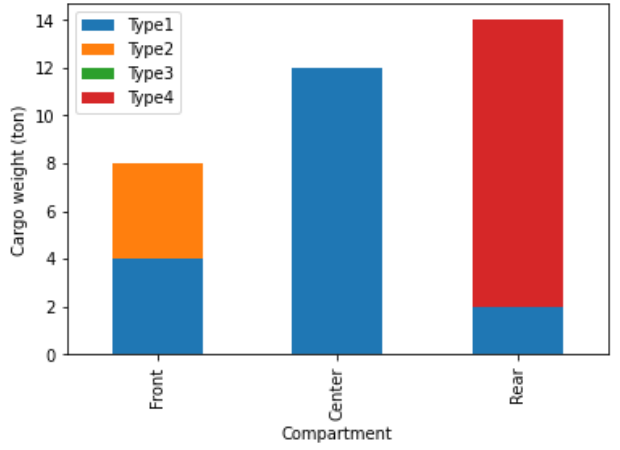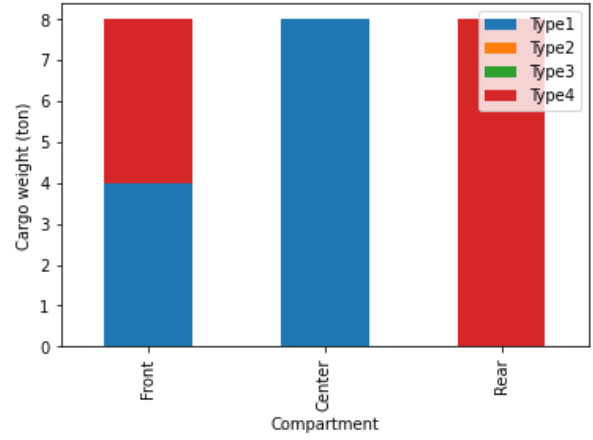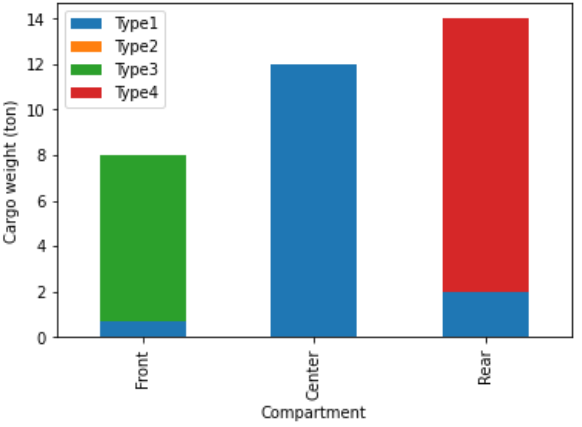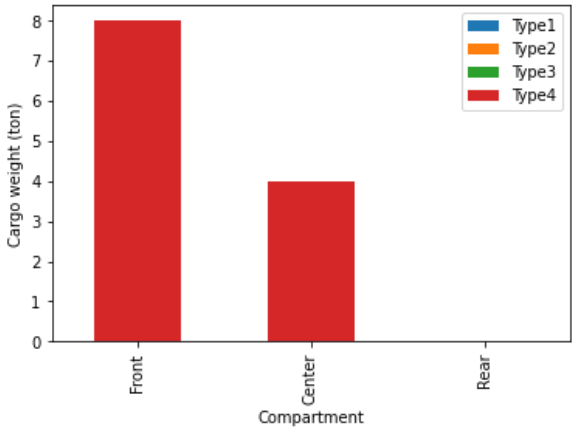Exercise 2: Cargo airplane (Optional)#
MUDE Exam Information
For the exam, you are expected to have a clear understanding behind the Simplex method and how to do it. you will not need to do the calculations by hand in the exam or on Friday’s assignment.
Original problem#
A cargo airplane has three compartments for storing freight: Front, central and rear. Each one of those compartments has the following limitations in weight and space:
Compartment |
Weight (\(\text{ton}\)) |
Volume (\(\text{m}^3\)) |
|---|---|---|
Front |
8 |
12000 |
Central |
12 |
10000 |
Rear |
14 |
6000 |
There are four cargo types, and the following maximum cargo (of each type) is available to be transported from a warehouse:
Cargo |
Maximum cargo available (\(\text{ton}\)) |
Unit Volume (\(\cfrac{\text{m}^3}{\text{ton}}\)) |
Unit profit (\(\cfrac{\text{€}}{\text{ton}}\)) |
|---|---|---|---|
Type I |
18 |
180 |
590 |
Type II |
14 |
250 |
580 |
Type III |
20 |
300 |
580 |
Type IV |
12 |
80 |
600 |
Task 1#
Build the mathematical programming model in order to define the amount of cargo of each type that should be transported and how it should be distributed in order to be efficient during the flight
Solution
Decision variables
Front |
Center |
Rear |
|
|---|---|---|---|
Type I |
\(x_{11}\) |
\(x_{12}\) |
\(x_{13}\) |
Type II |
\(x_{21}\) |
\(x_{22}\) |
\(x_{23}\) |
Type III |
\(x_{31}\) |
\(x_{32}\) |
\(x_{33}\) |
Type IV |
\(x_{41}\) |
\(x_{42}\) |
\(x_{43}\) |
\(x_{ij}\): weight of cargo of type \(i\) in position \(i\) in the airplane with \( i \in 1,2,3,4\) and \( j \in 1,2,3 \) Note: you can use as unit of the variables the volume too but in that case the constraints are going to be slightly different
Objective
If we define \(P_i\) as the profit obtained for one ton of cargo of type \( i \in 1,2,3,4\) then the objective function is to maximize the profit:
Constraints
Weight available to be transported at the warehouses:
Weight limits on the compartments:
Volume limits on the compartments:
Variables domain
Task 2#
Model the problem in Python using Gurobi.
Solution
The implementation is shown here.
Task 3#
Task 4#
What is the distribution of cargo for the optimal solution?
Solution

Fig. 5.6 Distribution airplane problem#
Challenges#
Challenge 1#
For efficiency purposes, the total weight transported in all compartments must be the same.
Task 1#
How do you change the model?
Solution
Additional constraints:
Task 2#
Task 3#
What is the distribution of cargo for the optimal solution?
Solution

Fig. 5.7 Distribution airplane problem challenge 1#
Challenge 2#
The weight of type I must be double the Type II and III together.
Task 1#
How do you change the model?
Solution
Additional constraint:
Task 2#
Task 3#
What is the distribution of cargo for the optimal solution?
Solution

Fig. 5.8 Distribution airplane problem challenge 2#
Challenge 3:#
The weight of cargo in the frontal area must be at least double the cargo in the rear and central areas together.
Task 1#
How do you change the model?
Solution
Additional constraint:
Task 2#
Task 3#
What is the distribution of cargo for the optimal solution?
Solution

Fig. 5.9 Distribution airplane problem challenge 3#
Attribution
This chapter is written by Gonçalo Homem de Almeida Correia, Maria Nogal Macho, Jie Gao and Bahman Ahmadi. Find out more here.
